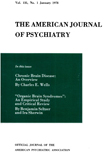Psychiatric Disorder in General Populations: A Study of the Problem of Clinical Judgment
Abstract
In most attempts to study the prevalence of psychiatric disorder, cases have been defined by applying clinical judgment to symptom data. In some of these, such as the Midtown and Stirling County studies, this has involved assessments of written records, consisting for the most part of data collected by lay interviewers. Findings from the present study (in the Washington Heights section of New York City) indicate that respondents from the general population are less likely to be rated cases on the basis of actual interviews by psychiatrists than on the basis of interview protocols. Moreover, this difference varies with the type of interview and with the social status of the respondent.
Access content
To read the fulltext, please use one of the options below to sign in or purchase access.- Personal login
- Institutional Login
- Sign in via OpenAthens
- Register for access
-
Please login/register if you wish to pair your device and check access availability.
Not a subscriber?
PsychiatryOnline subscription options offer access to the DSM-5 library, books, journals, CME, and patient resources. This all-in-one virtual library provides psychiatrists and mental health professionals with key resources for diagnosis, treatment, research, and professional development.
Need more help? PsychiatryOnline Customer Service may be reached by emailing [email protected] or by calling 800-368-5777 (in the U.S.) or 703-907-7322 (outside the U.S.).



